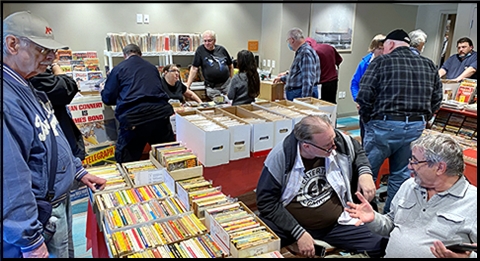November 2021
Monthly Archive
Sun 14 Nov 2021
Posted by Steve under
Reviews[16] Comments
REVIEWED BY DAVID VINEYARD:
H. C. BAILEY – Shadow on the Wall. Reggie Fortune novel #1. Victor Gollancz, UK, hardcover, 1934. Doubleday, US, hardcover, 1934. Rue Morgue, softcover, 2008. Note: Joshua Clunk appears in a small offstage role.
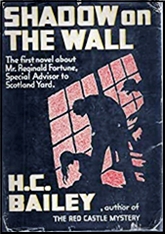
Reggie Fortune, that plump drawling darling of Harley Street, surgeon to the rich and famous and amateur detective par excellence has been out of favor roughly since the end of the Golden Age of the Fair Play Detective Novel. He has, in fact, been so out of favor even ardent fans of the genre would be excused if they only know his name by hearsay.
You can hardly find a short adventure of Reggie’s reprinted in even the most extensive anthologies of the genre, indeed, you are more likely to run across such rarities as Barnabus Hildreth or Dr. Eustace Hailey before you find one of Reggie’s adventures.
I don’t think there was ever an American publication of one of his books in paperback past the 1940’s and not much then, and while he gets a mention in Haycraft and by others, he is easily the least known of the fairly popular sleuths from the era, even Barzun and Taylor give him short shrift in Catalogue of Crime.
I don’t know exactly what I expected when I first started reading Bailey and Reggie Fortune. I knew from my reading that he tended to be annoying according to critics, that too many of his books involved children in danger, that he was chubby but not fat, and that he tended to be rude to policemen, but beyond that I couldn’t figure out exactly why that was more annoying than the some of the same traits in Peter Wimsey or Albert Campion.
I still don’t know what Bailey and Reggie did that so annoyed critics that they seemed happy to bury him.
Shadow on the Wall is the first novel length adventure of Reggie Fortune and it dives right in. At a Royal gathering Reggie meets with his friend Lomas, head of the Criminal Investigation of Scotland Yard, where they are accosted by Lady Rosnay who seems determined to see both attend her costume affair that evening.
She is also all abuzz about the scandalous death of Lucy Poynitz, the wife of a RAF test pilot who apparently committed suicide as a result of guilt over an affair with an unknown man. When, at that parties end Reggie learns her husband has died in a plane crash of unknown cause too, he is intrigued and decides against he best judgment to show up at Lady Rosnay’s that evening.
Attending the party doesn’t make things any clearer either. Lady Rosnay and a friend seem determined to let Reggie know they don’t trust Simon Osmond, an up and coming political figure sure to be the next Prime Minister if nothing stops him and with a reputation with the ladies.
Then there are some odd things going on, such as why would Lady Rosnay remove her jewels in the middle of the party, and what happened that led them to find her unconscious. Did she fall or was she hit?
No one is talking.
If you can’t make a mystery out of those ingredients you are in the wrong business, and Bailey isn’t.
Aside from Reggie Fortune Bailey also penned the adventures of Joshua Clunk, a less that scrupulous solicitor and wrote a number of fairly good swashbucklers. He knew his way around a plot and for all Reggie’s affectations he is often very effective in short form, and no worse at novel length than many of his fellow writers from that period.
More murder follows and Reggie finds himself deep in the middle of the investigation and closer to the truth than someone finds comfortable.
He heard a twig crack on which his own foot had not trodden. He looked aside and stepped behind a willow, and as he moved the crack of a shot came to him, a ping, a thud. He dropped prone behind the tree in bushes which scratched him, put his fingers in his mouth and whistled with all his might — gasped and whistled again.
Granted he’s not exactly the finest action writer you have ever read, but there’s decent atmosphere, and pretty good detective work by Reggie who plays great detective quite well.
I suppose some might have been bothered that Reggie turns up a conspiracy, the Maison Montrespan…
“The evidence is we are up against a group willing to take on any kind of dirty work…Now developed on a commercial basis. Organized business of crime. The mischief-makers unlimited. Ready to undertake dirty work for anyone who can pay.â€
Reggie will uncover the truth about the Maison Montrespan, reveal a murderer, and rise above the nasty business in true great detective manner before the final line, and its pretty entertaining, moving well enough, and with decent detection.
Reggie is no more annoying than any other great detective of the era, a “g†dropping lot if there ever was one, and while he is isn’t in the top class of puzzlers here, many of his short adventures hold up quite well and deserve reprinting.
As far as I know there is no single great Bailey novel or short. Maybe someone can name one. So far what I’ve read is capable though and often entertaining.
It feels as if Reggie got the blame for all the worst excess of the entire genre, and really doesn’t deserve it. For lovers of the genre, he and Bailey are well worth seeking out though I grant he is best taken in small doses.
Considering some of the drivel showing up in e-book form by the likes of Anthony Bathurst, H. C. Bailey and Reggie Fortune are classic works of genius.
Sat 13 Nov 2021
DÉTECTIVES. “Convictions intimes†(Firm Convictions). France Télévision Distribution. 22 May 2013 (Season One, Episode One). Sara Martins (Nora Abadie), Philippe Lefebvre (Philippe Roche), Jean-Luc Bideau (Maxime Roche). Currently streaming on MHz.

Roche and Son, a family owned and operated private eye agency, is running on hard time, and Maxime Roche the father, now retired, decides that to update the business – new technology and all — they need to join forces with another firm run by Nora Abadie (Sara Martins), a former French intelligence officer. Unfortunately he does not tell his son Phillipe, and the merger gets off to an obvious bad start.
The problem is basically this: Rocke and Son being a family-run business, they are too casual – not about their work – but in the office, with a couple of children having had free run of their previous location. It is hard for me to say, having watched only this, the first episode – and at that, one that ends in a cliffhanger – but it is easy to suppose that in spite of some initial antagonism between Nora and Philippe, opposites attract and the usual hesitant attempts at “will they or won’t they†will eventually prevail.

Not that there’s anything wrong with that.
Their first case in common is an unusual one. The Roches are investigating the death of a young worker at a nuclear plant, while Nora is/has been the director of data security of the company owning the very same nuclear plant. She decides, however, that she’d better investigate on her own, just in case the Roches discover something incriminating.
In spite of the seriousness of the case, there is a light touch to all of this that makes this go down easily, and at least for now, I intend to keep watching. Immediately after this series Sara Martins was to go on to become DS Camille Bordey on Death in Paradise, a role I continue to regret she decided to give up halfway through the fourth season.
Fri 12 Nov 2021
REVIEWED BY DAN STUMPF:
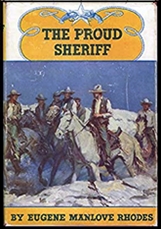
EUGENE MANLOVE RHODES – The Proud Sheriff. Houghton Mifflin, hardcover, 1935, with a preamble by Henry Herbert Knibbs. Dell #688, paperback. 1953 (cover by Robert Stanley). University of Oklahoma, hardcover/softcover, 1968/1977.
If you want an introduction to the works of a major Western writer, this will do very nicely. It opens with a lengthy foreword, detailing the life and character of Eugene Manlove Rhodes, then follows with an excellent novella detailing the activities of the proud Sheriff, Spinal Maginnis.
Maginnis is proud, a character explains, because there hasn‘t been a killing in his county in ten years. And because the Mexicans get along with the Americans, the miners get along with the ranchers, and the big rancher gets along with the smaller ones.
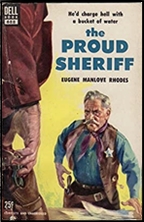
He’s proud that there aren’t many rich men in his county, but no one goes to bed supperless. And he’s proud because “I been sheriff here near to eight years and made my few and simple arrests with ne’eer a shot fired.â€
Shortly after the story opens, Maginnis’ first cause for pride gets squelched by a double murder. And as the story ends, so does his final boast. In between times, Rhodes offers up a rich, fast-moving story filled with colorful characters, spiced with humor, and moved along at a steady pace by sound detective work and bursts of action.
Mostly though, this is the story of Spinal Maginnis, the proud sheriff, and here Rhodes provides a character distinctive, well-rounded, and fascinating enough to keep the reader (this reader anyway) up way past bedtime.
Fri 12 Nov 2021
Posted by Steve under
Reviews[2] Comments
DAVID HOUSEWRIGHT – A Hard Ticket Home. Rushmore McKenzie #1. St. Martin’s Press, hardcover , 2004. Leisure, paperback, March 2006.

There is a small but significant subgrouping of PI novels and other tales that consists of PI’s who aren’t really PI’s, but who are so rich that they can take on cases for free on behalf of friends and other people he knows, but who can’t pay for real (licensed) PI’s.
Such is the case of St.Paul MN-based non-PI Rushmore McKenzie. He quit the police force in order to be able to accept a finders fee from an insurance company after tracking down an embezzler who’d stolen six million dollars for them.
In this, his first case (of a total of eighteen now), he goes hunting for a missing daughter whose blood type as a donor is what her parents need as to help save another, much younger daughter. Little does Rush know what he’s about to get into. A serial killer of sorts, an elite club of Minnesota socialites, a gang of ruthless urban hoods, and all layers of society in between.
Rush is the kind of guy who gets himself into bad situations for bad reasons without thinking about the possible consequences, and he pays the price for it. He also loses one long-time girl friend, but they are hints that he will soon have another. It’s a lengthy investigation, with several twisting trails to follow, and if you expect them to be tied up in a single well-wrapped package, you may be mistaken.
Readers who love hard-boiled PI fiction will find much to like with this one. And if you like it as much as I did, you’re in luck. There are, after all, seventeen more of them.
Thu 11 Nov 2021
Posted by Steve under
Reviews[3] Comments
REVIEWED BY MARYELL CLEARY:
ALICE TILTON – The Iron Clew. Leonidas Witherall #7. Leonidas Farrar Straus & Co., hardcover, 1947. Foul Play Press, paperback, 1992.
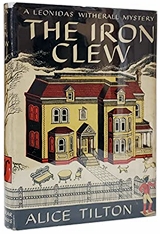
“In one foul sweep,” says Mrs. Mullet, housekeeper to Leonidas Witherall … and though that memorable malapropism occurs on the last page, it is characteristic of the entire book. Phoebe Atwood Taylor, writing as Alice Tilton, packs more misapprehensions, missed appointments, and mistaken identities into one book than any mystery writer I know.
They are funny, too, unless the reader tries to read too many of her books one after the other and falls afoul of the basic likenesses of plot, characters, and even clues in them all.
Nevertheless, this romp through winterset New England towns, chasing missing brown paper packages, and finding missing people, is hilarious if you don’t think too seriously about what is going on. Don’t try to believe it, just enjoy it, is my advice!
– Reprinted from The Poison Pen, Volume 3, Number 4 (July-August 1980).
Wed 10 Nov 2021
Posted by Steve under
Reviews[7] Comments
REVIEWED BY DAVID VINEYARD:
DAVID HUME – Invitation to a Grave. Mick Cardby #? Collins Crime Club, UK, hardcover, 1940. No US edition.
“The first figure I see in that doorway I’ll drop … and this close I couldn’t miss if I closed my eyes and fired blind… Maybe they’d like to die suddenly. Well if they do they’ve never been given a better chance than they get now.â€
Mick Cardby in a tight spot in Invitation to a Grave.
The British Private Eye story started about a decade later than it’s American cousin, and really didn’t take hold of the public imagination until the mid to late Thirties. Not that there hadn’t been private detectives in British fiction earlier. From consulting detective Sherlock Holmes to the likes of Sexton Blake, Arthur Morrison’s Martin Hewitt, and Dick Donovan, they just tended to run on very different lines than the American model, mostly gentlemen, though Dick Donovan could be a little rough around the edges and Martin Hewitt was decidedly middle aged and middle class.
Once in a while one of the Golden Age amateur sleuths would open a detective agency for the sheer fun of it, and a few of the gentleman crooks and adventurers like Anthony Armstrong’s Jimmy Rezaire, Frank King’s the Dormouse, Hugh Cleveley’s Maxwell Archer, and Wyndham Martyn’s Anthony Trent had offices at one time or another. Even Arsene Lupin took a turn as Jim Barnett, an American private detective in blue spectacles in Paris, while Harry Dickson was the German then French Sexton Blake. G. K. Chesterton’s Flambeau reformed and became a private eye, but as with most of the British entries he was a far cry from Philip Marlowe or Sam Spade
It was Peter Cheyney, first with G-Man Lemmy Caution then with British eye Slim Callaghan, who really kicked the door in. Then with the success of James Hadley Chase’s mock American eyes suddenly the British thriller genres was overrun with fedoras, trenchcoats, wisecracks, and gats.
Gerard Fairlie who had penned adventures of the Vulture, Victor Caryl, and Bulldog Drummond (who was based on him) had ex-Yard man turned eye Johnny McCall narrating his own adventures in proper Cheyney style, John Bentley gave us Dick Marlow who took to Rye and Brandy in his titles and got involved in standard thriller fare but with a tough guy voice, John Creasey, whose Toff acted a bit like an unpaid eye, gave us twin private eyes Richard and Martin Fane (named after his sons), Basil Copper gave us yet another faux American eye by the name of Mike Faraday, E. Quinn Baker (a woman) even anticipated the voice of Raymond Chandler with her ex-Yard man/ex-con private eye James Strange, and Peter Cheyney expanded his base with Johnny Vallon, Nick Bellamy, and a string of one-off private eye heroes. In later years even a lot of the gentlemen crooks behaved less like crooks than private eyes and secret agents including the Saint once in a while.
But for my money the best of the lot of the British eyes from the first era, the top of the heap, was David Hume’s rough tough fast-quipping boy Mick Cardby.
Mick is quite the lad. His father, Mick Senior ex-Inspector Cardby of the Yard, runs Cardby and Cardby Investigations with youngster Mick II (never junior) as his partner in an adjacent office (they share a sexy secretary who has a no funny business rule). Senior is a tough old bird, but he has nothing on Mick, who, while often referred to in terms of his relatively young age, is as tough with his fist and fast with his gun as Race Williams in his heyday, if not a great deal smoother in patter when exchanging fists or lead
Mick is a long way from Bulldog Drummond’s drivel or the Saint going poetic. His grammar is colored with British street slang and his attitude much less gentlemanly.
Rough edges, our boy Mick. Decidedly rough edges. It helps he is as devious as Sam Spade, as slippery as Slim Callaghan, and like Michael Shayne isn’t afraid to use brains or fists.
This young Cardby might talk like a fool at times, but the levity was a pose, a rest from sterner stuff.
His milieu is the same as Hume’s great model Peter Cheyney: the West End night clubs where slinky chanteuses belt out sultry songs in dark clubs filled with blue gray cigarette smoke, and, more often than you might expect in London, the smell of cordite, and the East End slums where criminals drop their ’haitches and acknowledge Mick as “Guv”.
The British model came out of the British weekly paper The Thriller, which was to the gentleman crook and adventurer what Black Mask was in this country to the private eye. Early on Hume contributed some decent Scotland Yard tales in an Edgar Wallace vein there, but it was with Mick Cardby his fortunes blossomed.
And it’s not surprising. Mick is an attractive lad, handsome, tough, fast on his feet and not afraid of crook or cop, his relationship with Scotland Yard a complex one, many like him and his father, and aren’t averse to looking the other way at his methods, but they could never publicly approve. They do however look the other way enough some of them must have spent a fortune on liniment for the sore necks.
“If you are not in my office in the next quarter of an hour I’ll be along to find you and there’ll (sic) be an arrest warrant out for you …â€
The relationship to the American model pretty much ends there though. Mick’s adventures are more thriller than hard boiled. For all the fog and sultry dames his world is one of melodrama and not noir. That faint hint of something political and just a bit working class is missing from the British private eye genre. For all their attitude you could dress Mick or one of Cheyney’s heroes up and probably pass them off without notice in Buchan’s Rungates Club, at least until they started blabbing half-digested Americanese. They may sail through Whitechapel as if they owned it, but they clean up well enough for Mayfair.
Hume was popular too, at least in Great Britain and the Commonwealth. Three films were made from his books, and while Cardby senior showed up in all three as a Yard man, Mick himself only appeared as himself in one, but when he did it was as played by James Mason, who gave a mean impression of the character
Invitation to a Grave opens with international skullduggery, kidnappings across the world, even in Chicago, and someone letting it be known the boss of the outfit is Mick Cardby.
Luckily for Mick when he is summoned to the Yard by Inspector Wales of Special Branch they don’t buy it. Of course they can’t clear him officially, but they can look the other way for twenty-four hours while Mick works his magic, as long as he doesn’t litter the streets with too many corpses. There is pressure from multiple foreign police including the FBI to have him picked up and held, and pressure too coming from inside the Yard so Mick has to avoid being arrested as a wanted man while solving the mystery..
As usual Mick is up to his neck in it. And when he heads back to his office to enlist his father things have escalated … while he was at the Yard someone snatched his father and drove off with him.
Now Mick has twenty-four hours to free his father, track down the mastermind (this one is a doozy) using his name, break up a dangerous international gang of kidnappers and extortionists, and all while ducking Scotland Yard as a wanted man.
“…a crime wave has hit London today. There was a murder at the Cosser Hotel, another at Brentham, and now a third at the Hotel Royal, Regent Street…there have been two cases of kidnapping…my father was snatched this morning…This afternoon a man working with me…has also been either kidnapped or murdered.â€
Part of the fun of Hume as a writer is that he never dallies. He plunges straight ahead, trained in the pages of The Thriller to keep the plot and action moving, which he does with one well choreographed set piece after another.
Granted, like most pulp writing, it is sometimes written too hastily, and not every book is as tight as we might want, but this is not written to dwell on. It is written to experience at a breakneck pace, a few words a night or over a weekend before bed or while listening to the radio, bullets flying, dames who vary from swell to deadly, and a wide assortment of crooks including invariably a mastermind in the shadows Mick will smoke out with gunsmoke and brains.
“How the hell did you manage this job, Cardby? It is magnificent.â€
“I thought so myself,†said Mick.
Race Williams couldn’t have said it better.
Wed 10 Nov 2021
Tue 9 Nov 2021
CON REPORT:
Pulp AdventureCon, November 6, 2021
by Walker Martin
I’ve attended all these annual Pulp Adventurecons, over 20 of them, most of them in Bordentown, NJ (there also is a Florida show which I’ve never been able to attend). The first one was in the woods somewhere at a firehouse. Several of us got lost trying to find it. I remember there being maybe ten tables and about 50 attendees, maybe less.
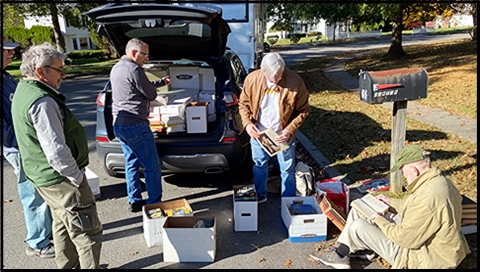
Left to right: Nick Certo, Paul Herman, Richard Meli, Digges La Touche.
But it certainly has grown! This year the show was held in a new hotel in Bordentown, and I liked the new venue though I wish the dealers were all in one big room instead of two smaller rooms. There were over 40 tables and what looked like well over 100 attendees. I was happy to see the hotel had free coffee and egg sandwiches available in the morning.
A year ago I reported on the show held in November 2020 (Book Hunting during the Pandemic) and I received some negative criticism on one of the online discussion groups. But my entire life has been consumed by my desire to collect books and pulps, not to mention original cover and interior art.
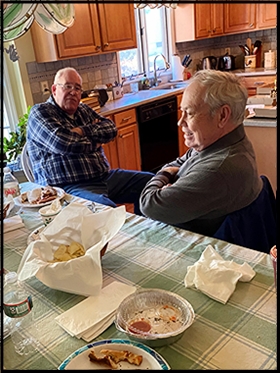
Left to right: Ed Hulse, Steve Lewis.
I’ve been a bibliomaniac now for over 65 years ever since I discovered Edgar Rice Burroughs, Erskine Caldwell’s Signet paperbacks with the sexy James Avati covers, and the SF digest magazines. I’m not going to go into hiding because of the virus. In fact what better death for a book collector than to die hunting for collectible books, vintage paperbacks, pulps, and artwork? With that attitude, I guess that’s why I have a large collection.
Last year the hotels were requiring masks and social distancing, but this year masks were optional and we all happily squeezed into the two rooms and bought and sold books, magazines, and DVDs.
Though this convention is a one day show, it feels a lot longer. Each year it seems to last several days. To give you an idea I will briefly list each day’s events at my house:
Wednesday, November 3
Matt Moring of Steeger Books has for several years arrived on Wednesday before the Saturday convention. He does some research for upcoming books, and we meet for dinner. There are plans for a special Thanksgiving sale, and he soon will announce the upcoming publication of around 40 new volumes in the Steeger Books reprint series.
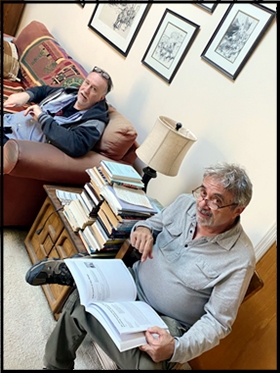
Left to right: Scott Hartshorn, Nick Certo.
That’s right, 40 new books! This has to mean that Matt has published over 500 books in the last few years. If not 500, then very close to it. There will be new books in the Dime Detective Library, the Argosy Library, and important releases reprinting Talbot Mundy, The Spider and others including perhaps H. Bedford Jones. There will be a great release coming soon dealing with The Campfire letter column in Adventure.
Thursday, November 4
Richard Meli and Scott Hartshorn arrive from Florida. I’ve been friends with Scott since 1976 when he was a teenager and thought I was an old man even then at age 34. He must think I’m really old now. Scott is a long time art and book collector with a love for film noir movies, a passion I share.
Richard Meli is the man behind Heartwood Books and Art and also happens to be a physician. I mention this because every book convention should have a doctor on call in case an elderly collector collapses or faints from the terrific stress of trying to buy every damn book and pulp magazine in sight.
Actually I thought Rich Meli might keel over since he bought so much and was so excited. Maybe we need two doctor/collectors, in case one collapses, the other could care for him. There were now five of us and we had lunch and dinner together.
Friday, November 5
This is the day of my annual brunch that I host every year just prior to the Bordentown convention. I can’t handle a big crowd of insane book collectors, so I try to keep attendance at around ten. I used to have hoagies, potato salad, chips and beer and soda but I couldn’t depend on the delis to have the food ready for Friday at 1:00 pm, so the last couple years I’ve ordered pizzas for everyone except for one collector who hates pizza. So I ordered a steak sandwich and fries for him.
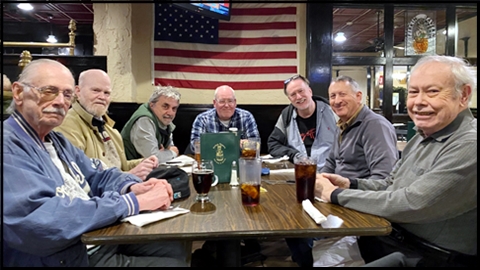
Left to right: Walker Martin, Digges La Touche, Nick Certo, Ed Hulse, Scott Hartshorn, Paul Herman, Steve Lewis
During this brunch, a lot of selling and buying goes on. To give you an idea, this year a nice condition set of Thrilling Wonder changed hands. Also nice sets of the Ziff Davis Amazing and Fantastic Adventures, two sets of Planet Stories, a nice stack of All Western and many individual issues of detective and western pulps.
In fact the weather was so nice and sunny that we were buying books and pulps outside at the curb in front of my house and out of the back of cars and pickup trucks. Two of my neighbors were walking by and commented on the mass of books and magazines on the grass and sidewalk. I’ve known them 25 years and little did they know I also had a house full of books! Non-collectors just don’t know the true insanity of collectors.
Then after 5 pm we all met at Firkin’s Tavern for dinner. Matt Moring has sent some photos showing us in the Irish pub. In addition to myself, also in attendance were Matt Moring, Nick Certo of Certo Books, Scott Hartshorn, Ed Hulse of Murania Press, Digges La Touche, Paul Herman, book seller, Steve Lewis of Mystery*File, Richard Meli of Heartwood Books and Art. My wife, being a non-collector was absent because so many collectors in the house at one time freaks her out.
Saturday, November 6
The day of the convention! Matt Moring picks me up at 8 am and we arrive at 8:30. Matt quickly sets up five long boxes of pulps, all priced at only $5.00 each, easily the bargain of the convention. John Gunnison and his wife were already set up with what looked like five tables of pulps or an entire wall of the room. Cowboy Tony was there with three tables of all sorts of paper products: pulps, fiction digest magazines, slicks, comic strips, men’s adventure magazines and risque magazines.
Ed Hulse was selling his brand new book on vintage paperbacks: The Art of Pulp Fiction. Martin Grams had his usual tables of DVDs, Paul Herman had hundreds of vintage paperbacks. Gary Lovisi and his wife were selling his excellent magazine Paperback Parade. Nick Certo had books and paperbacks. This is just a sample of the books available. There were many more dealers. After the convention closed at 5 pm, many of us ate dinner at Mastoris Diner, another long time tradition.
The people behind this long running show are Rich Harvey, Audrey Parente, and Rich’s father was taking care of admissions. Thank you for your efforts and usual fine job!
Sunday, November 7
Matt and I went out for breakfast and we talked about a possible art trade but we couldn’t reach agreement. Maybe next year.
Monday, November 8
Scott Hartshorn and Digges La Touche met me for breakfast and afterward we took Scott to the airport.
So ends another Pulp Adventurecon. See you at Windy City and Pulpfest!
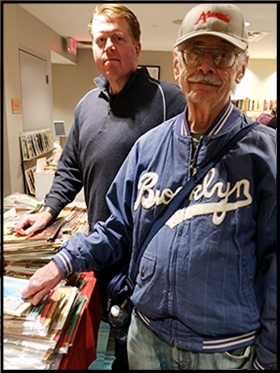
From left to right: Matt Moring, Walker Martin.
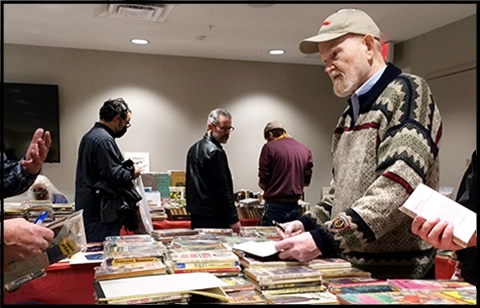
Digges La Touche.

Paul Herman
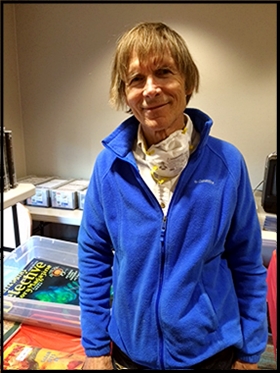
Andy Jaysnovich
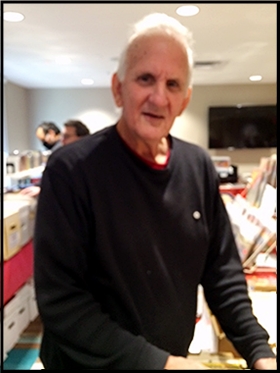
Gary Lovisi
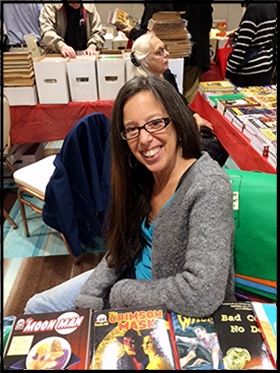
Gary’s wife Lucille
Mon 8 Nov 2021
Posted by Steve under
Reviews[7] Comments
REVIEWED BY DAN STUMPF:
FREDRIC BROWN – His Name Was Death. Dutton, hardcover, 1954. Bantam #1436, paperback, 1956. Black Lizard, paperback, 1987/1991.
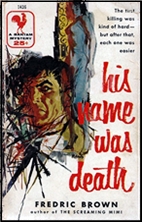
Fredric Brown at the very top of his form: tricky, entertaining, and compulsively readable.
This is ostensibly the story of Darius Conn, successful wife-killer and novice counterfeiter, and his attempt to track down some bogus bills that have gone astray. Having already gotten away with the murder of his wife, Conn sees no problem with committing a few more perfect crimes to cover his latest felony, so he tracks each bogus bills to whoever’s holding it, and… and Death becomes a fast-moving and sardonic tale of multiple murders.
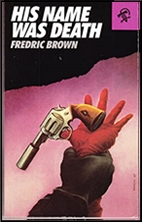
But that’s only on the surface. The genius of His Name Was Death is that the reader thinks he’s reading one story, when Brown is actually telling a completely different tale. And when the hidden story surfaces, it rears its surprising head with all the fatalistic power of a Greek Tragedy.
There’s a wonderful moment toward the end of the book when Conn’s crime spree seems to be heading irreversibly towards another murder: The reader can see and feel that there are only a few pages left, and the reader knows this story will end soon and that it shouldn’t end with the killer going free, but that it must.
And Fredric Brown resolves the issue with the brilliance that was uniquely his. This is a top-notch tale and one I recommend highly.
Sun 7 Nov 2021
Posted by Steve under
General[3] Comments
I spent the weekend in Bordentown, New Jersey. Big whoop, you say, but that otherwise totally innocuous town was also the site of this year’s Pulp Adventurecon. I had a great time — it was the first such pulp-paperback type convention I’ve been able to get to in over three years. More details — with photos — soon!
« Previous Page — Next Page »












